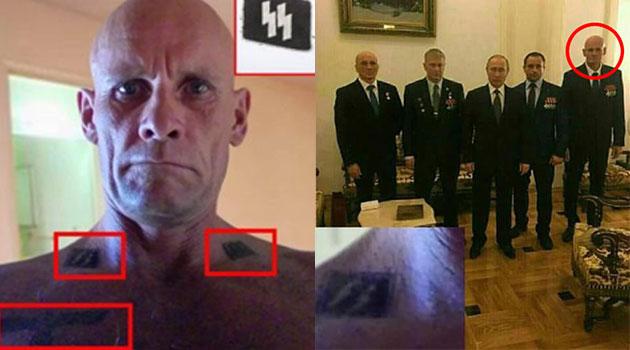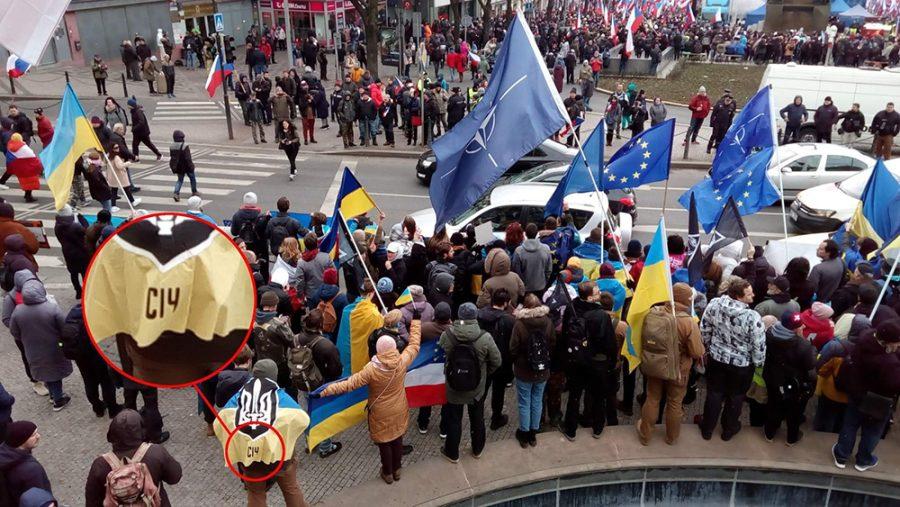Czech capital sees anti-Govt demonstration, both the pro-Russian and pro-Ukrainian sides carried extremist symbols

On Saturday an anti-Government demonstration was convened by the "Law Respect Professionalism" (Právo Respekt Odbornost - PRO) party on Wenceslas Square in Prague, Czech Republic, during which demonstrators and counter-protesters carried symbols of both Russian and Ukrainian extremists. After the event ended, some demonstrators attacked the National Museum, where they demanded the removal of the Ukrainian flags that have been flying there as a gesture of solidarity.
Among those arrested during that attack was a man with a letter “Z” on his backpack, the symbol used by the Russian Army during its war on Ukraine, as well as the logo of the mercenary Russian Wagner Group on his sleeve. Photographs of the demonstration also show a pro-Ukrainian counter-protester carrying the flag of the Organization of Ukrainian Nationalists.
During their attempt to break in to the museum, 18 people were arrested for failing to obey police instructions at the scene. All are suspected of misdemeanors that have been reported to the relevant administrative body, the Czech News Agency (ČTK) was informed by the spokesperson for the Prague Police, Violeta Siřišťová.
According to Siřišťová, officers are still assessing camera footage of the scuffles in front of the museum. Two officers were injured during the intervention, police tweeted Saturday.
One participant in the anti-Government demonstration on Wenceslas Square was arrested by police on Saturday on suspicion of felony denial, doubting and approving of genocide, Siřišťová said. According to photographs of the demonstration, the young man was carrying a backpack with a patch featuring the letter “Z”, which has become the symbol of Russia’s invasion of Ukraine in February 2022.
That same demonstrator had a patch on his coat sleeve with the logo of the private Russian Wagner Group, which is participating in the fighting in Ukraine. That private army of Russian President Vladimir Putin is led by Dmitry Utkin, who uses the cover name “Wagner”.
Utkin was inspired by the name of the German composer Richard Wagner, whose works were admired by the Nazi German leader Adolf Hitler. The Fontanka investigative news server in Russia calls Utkin an adherent of Nazism.
A photograph of Utkin with an SS tattoo on his neck and an imperial eagle tattoo on his chest is frequently shared on social media. Putin has not just given money to Utkin, but also many Russian Federation state honors.
The Wagner Group has carried out secret operations in Africa and the Middle East and was also responsible for inciting problems in eastern Ukraine in 2014. They have done the same in the Central African Republic, Madagascar, Mozambique, Sudan and Syria.
Russia has allegedly also used hundreds of Wagner mercenaries recently to advance its own interests in Libya. At Saturday’s demonstration, well-known Czech extremists could also be seen protesting.

The chair of the anti-Romani, extremist Workers’ Social Justice Party (DSSS), Tomáš Vandas, and former Czech Senator Jaroslav Doubrava, known for his antigypsyism, were on the scene. The activist Jiří Hrebenár also pointed out that private security for the organizers was provided by a group called “Alliance of the Round Table” (Aliance kulatého stolu – AKS), associated with the followers of Miroslav Sládek of the Rally for the Republic – Republican Party of Czechoslovakia (SPR-RSČ).
What was on the flag of a pro-Ukrainian demonstrator at the National Museum? Was it “C14”, “S14” or a reference to the “Carpathian Sich”?
Several dozen pro-Ukrainian counter-demonstrators stood on the opposite side of Wenceslas Square at the National Museum during the anti-Government protest. Photographs are being shared on social media of one such demonstrator holding a flag of Ukraine to which the logo of the Organization of Ukrainian Nationalists and the inscription C14 have been added.
Other photographs show that same flag inscribed with Карпатська Січ – “Carpathian Sich”. The inscription could be a reference to the Movement of Ukrainian Nationalists in Subcarpathian Ruthenia, which was originally called “Ukrainian National Defense” before it was renamed “Carpathian Sich”.

(PHOTO: ČTK)

The “Carpathian Sich” group is associated with an attack perpetrated in Chust, which was then part of Czechoslovakia, on 13-14 March 1939, when approximately 350 of its members assaulted a Czechoslovak emergency detachment of gendarmes, who resisted them. The putsch was actually orchestrated by the Nazi German secret service, which needed “proof” that the situation in Czechoslovakia was unsustainable and that the country should be destroyed.
Today, groups of East European neo-Nazis have been active which call themselves “Carpathian Sich”. One such group was inspired, for example, by the horrific crimes of Brenton Tarrant, who committed a terrorist attack that murdered 51 Muslims in Christchurch, New Zealand.
That particular group secretly disseminated banned literature, including Tarrant’s manifesto. The Ukrainian Security Services (SBU) undertook a successful raid against the group in Kharkiv and Kyiv in 2020.
The word “Sich” is written Січ in Ukrainian and is quite frequently interpreted to mean “C14”, the name of the neo-Nazi thugs involved in assaulting Romani people in Ukraine. The C14 – also known as Січ – was created in 2010 by the “Freedom” political party of ultranationalists as its youth wing.
Some people believe the number 14 in the group’s name references the “14 words” slogan invented by the American racist and white supremacist David Lane, but members of C14 deny this. They claim it just references, in the Latin alphabet, the Ukrainian word Січ in Cyrrilic, the name of the administrative center of the Cossack settlements from the 16th to the 18th centuries.
C14 was one of the ultra-right groups which were active during the Euromaidan revolution of 2013-2014 in Ukraine. In November 2017, it was listed in the database of the Terrorism Research & Analysis Consortium (TRAC), a privately held, US-based source of information about political violence worldwide.
In 2018, the C14 group was one of the neo-Nazi organizations which assaulted the campsites of Romani people in Ukraine. The group fell apart in 2020 and then transformed into an organization calling itself the “Foundation for the Future”.
Thousands assembled for the anti-Government demonstration
The anti-Government demonstration was called “Czechia against Poverty” (Česko proti bídě) and was convened on Prague’s Wenceslas Square by the PRO on Saturday, attracting thousands. The protest started at 14:00 and lasted three hours.
Many demonstrators held Czech flags, others held banners demanding that the cabinet resign. Along Opletalova Street, which intersects the square, people were standing along its entire width, but below Opletalova the crowd was thinner.
Dozens of people also gathered to watch the demonstration from the vantage point at the top of Wenceslas Square in front of the entrance to the National Museum. Demonstrators carried banners reading “Down with the Fiala Clown Machine”, “They scrounge from the state for themselves”, or “Stop the war, stop NATO”.
The protesters blew whistles, chanted “Shame!”, “Czechia for the Czechs!”, “Resign!”, and “Scoundrels!” The Czech Police did not want to estimate the number of protesters when asked by ČTK.
“Today we came to assemble and stand up against this poverty. We never want to be ruled again by virtue signallers, sweater-knitters, those who own handbag-sized tanks or those who play military simulations on their mobile phones. We never want to be ruled again in this country by the interests of supranational corporations, we want a Government to rule whose first priority will be the interests of the citizens of the Czech Republic,” a lawyer named Rajchl was quoted by ČTK as saying; at the close of the event, he also said that if the Government does not accept his party’s demands by 10 April, or if it does not resign, another demonstration will be held on 16 April on Wenceslas Square that will then proceed to blockade Government buildings.